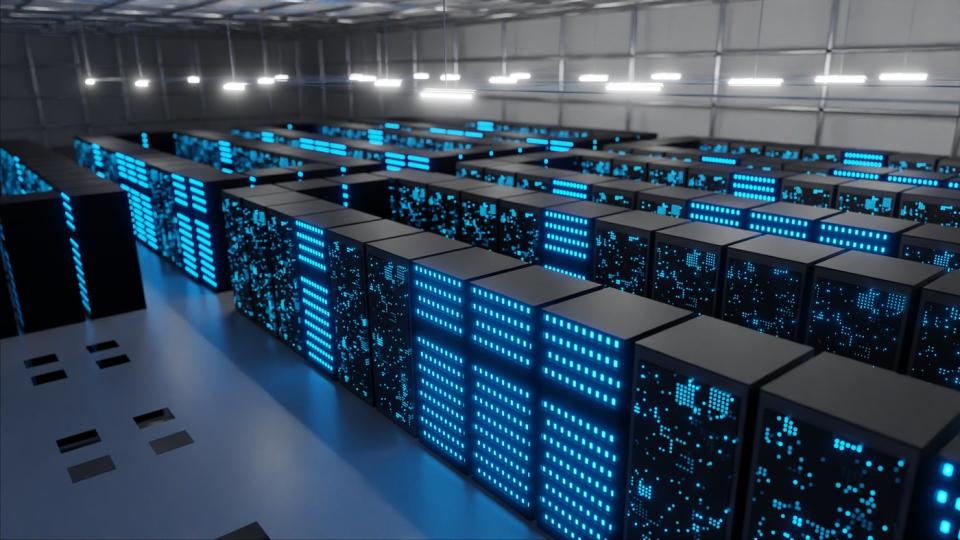As this earnings season has shown, large companies continue to invest heavily in AI. But one problem has been the massive electricity needs of these power-hungry AI servers. And with even higher-powered AI chips coming next year, this problem is set to compound.
To alleviate AI’s massive power needs, data center operators are just starting to adopt direct liquid cooling (DLC) for AI server racks, as opposed to the traditional air-cooled racks used in the vast majority of data centers today.
Liquid-cooled data centers made up only about 1% of the market heading into this year but are now set to take off, perhaps leading to a big upheaval in the fast-growing AI server industry. With its long history of leading in new energy-efficient technologies, it’s no surprise that Super Micro Computer (NASDAQ: SMCI) is positioning itself to dominate this industry disruption.
From 1% to 15% in the blink of an eye
Liquid cooling has been only 1% of the data center market until now because, traditionally, it takes a long time to deploy, costs more, and leaks can cause component failure. Moreover, managing liquid-cooling systems takes a different kind of expertise than managing air-cooled systems.
However, it appears as though Supermicro may have cracked some sort of code in deploying liquid-cooled racks at scale. And that could be a big deal.
While analysts squirmed over the decline in Supermicro’s gross margins last quarter, the decline may actually be good news for long-term investors. According to management, since unveiling its new liquid-cooled solutions at Computex in early June, the company has seen stronger-than-expected demand for its liquid-cooled racks. Therefore, the company had to pay for expedited shipping for liquid-cooling components, which cost more and hurt gross margins last quarter.
However, stronger-than-expected demand is not a bad problem to have. On the recent earnings conference call, Supermicro CEO Charles Liang said the company had shipped about 1,000 liquid-cooled racks in June and July, which Liang said amounted to more than 15% of all new global data center deployments globally over those two months. Liang also noted that Supermicro is forecasting that 25% to 30% of all new data center deployments will use DLC solutions over the next 12 months, “with most deployments coming from Super Micro, we believe.”
Supermicro is investing to dominate this market
In the pre-AI world of traditional servers, Supermicro’s premium, customized servers tended to have a relatively low market share in the fragmented industry of enterprise servers, at around 5%. However, Liang thinks Supermicro accounts for “at least” 70% to 80% of all the DLC servers shipped over the last few months.
While it’s unlikely that Supermicro will hang on to that much market share over time, the company is clearly making the investments today to maintain a leading market share in DLC.
That could turn the enterprise server industry on its head, given that DLC is very rapidly going from 1% to potentially 30% of the server market in just one year. The explosion of DLC revenue is why Supermicro projects $26 billion to $30 billion in revenue over the next 12 months, roughly a doubling relative to the $14.9 billion it just made in the 12 months ending in June.

Why Supermicro isn’t charging more
When executed well without leaks, DLC’s advantages include up to 40% lower power consumption, better computing performance, and a faster time-to-online due to not having to install large air conditioners, all while lowering a data center’s carbon footprint.
Given that, analysts are wondering why Supermicro isn’t charging more. The company saw its gross margins fall to 11.3% in the quarter, partly due to expedited shipping costs, but it is only targeting a return to its traditional 14% to 17% gross margin range by the end of this year.
But if you have a value-add solution, such as DLC, you have two options: Either charge a higher price or try to disrupt the industry with large volumes at a lower price. Supermicro is apparently taking the latter disruptive path, at least at this early stage of the liquid-cooling era.
That may prove to be the smart long-term strategy, as it could pave the way for more market share. AI is a revolutionary technology, but it is expensive. Therefore, Supermicro keeping prices low could open more overall spending on AI servers from its customers. And if DLC eventually costs only on par with air-cooled servers, it could potentially be deployed even in traditional data centers, too.
With Supermicro also deploying a new data center building block solution (DCBBS) later this year — which incorporates end-to-end data center construction, including maintenance software and services — the company may generate more recurring maintenance/software revenue attached to its deployments than it did in the past when it was just a hardware parts provider.
So, getting more high-volume customers up front could be a smart move. Furthermore, Supermicro’s costs are likely to come down next year as its new Malaysian manufacturing plant comes online in November with dramatically lower costs.
While many Supermicro investors appear to want more profits now, the company’s heavy investments in taking the lead in direct liquid cooling for AI data centers — perhaps a big lead — could prove to be a game-changer.
Should you invest $1,000 in Super Micro Computer right now?
Before you buy stock in Super Micro Computer, consider this:
The Motley Fool Stock Advisor analyst team just identified what they believe are the 10 best stocks for investors to buy now… and Super Micro Computer wasn’t one of them. The 10 stocks that made the cut could produce monster returns in the coming years.
Consider when Nvidia made this list on April 15, 2005… if you invested $1,000 at the time of our recommendation, you’d have $641,864!*
Stock Advisor provides investors with an easy-to-follow blueprint for success, including guidance on building a portfolio, regular updates from analysts, and two new stock picks each month. The Stock Advisor service has more than quadrupled the return of S&P 500 since 2002*.
*Stock Advisor returns as of August 6, 2024
Billy Duberstein and/or his clients have positions in Super Micro Computer and has the following options: short January 2025 $1,840 calls on Super Micro Computer, short January 2025 $110 puts on Super Micro Computer, short January 2025 $125 puts on Super Micro Computer, short January 2025 $130 puts on Super Micro Computer, short January 2025 $280 calls on Super Micro Computer, and short January 2025 $85 puts on Super Micro Computer. The Motley Fool has no position in any of the stocks mentioned. The Motley Fool has a disclosure policy.
Super Micro Computer Just Made a Game-Changing Move. Here’s What You Need to Know. was originally published by The Motley Fool
Source Agencies



